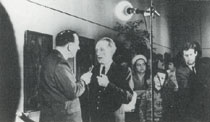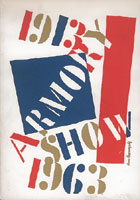recorded by Richard N. Miller
[The following is the transcript of the talk Marcel Duchamp (Fig. 1A, 1B) gave on February 17th, 1963, on the occasion of the opening ceremonies of the 50th anniversary retrospective of the 1913 Armory Show (Munson-Williams-Procter Institute, Utica, NY, February 17th – March 31st; Armory of the 69th Regiment, NY, April 6th – 28th) Mr. Richard N. Miller was in attendance that day taping the Utica lecture. Its total length is 48:08. The following transcription by Taylor M. Stapleton of this previously unknown recording is published in Tout-Fait for the first time.] Announcer: I present to you Marcel Duchamp. (Applause) Marcel Duchamp:
(aside) It's OK now, is it? Is it done? Can you hear me? Can
you hear me now? Yes, I think so. I'll have to put my glasses on.
As you
all know (feedback noise). My God. (laughter.)As you
all know, the Armory Show was opened on February 17th,
1913, fifty years ago, to the day (Fig. 2A, 2B). As a result
of this event, it is rewarding to realize that, in these last fifty
years, the United States has collected, in its private collections
and its museums, probably the greatest examples of modern art in the
world today. It would be interesting, like in all revivals, to compare
the reactions of the two different audiences, fifty years apart.
If only a happy few in this room actually saw the Armory Show of 1913,
all of you have heard and read so much about it that we all are very
familiar with the kind of reception the public of 1913 gave to it.
It was a veritable bataille d’ [inaudible] with
such weapons as derision, contempt, caricature, engaged in approval
and defense of a new form of art expression, a battle which seems,
today, hard to imagine.
In Europe, this same period of 1910-1914 has been called the heroic epoch of modern art, and had its convulsions in the shows of the Independents and the Salon d’Automne of 1911 and 1912. But the reaction of the European public was only a mild cry of indignation in comparison to the negative explosion at the Armory Show. The public of 1963 will certainly not be shocked. All of the paintings and sculptures have been seen or reproduced so often during the last 50 years, and particularly after having been part of the controversy of 1913, most of them have established their worthiness. In other words (laughs), in other words, today, the public, in order to judge, will be on a more understanding and critical level, and fully aware of the concentration [inaudible] by the 50 years of survival. A feeling of reverence, with nostalgic overtones, will certainly prevail in the final verdict by our present aesthetic standards. I hope, this afternoon, to add a little note to the Show itself, by showing you a number of works which were in the 1913 exhibition, but could not, for different reasons, be obtained for the present show. I will also show a few others, which, although in neither show, reflect the spirit of that period. The aim of the Munson-Williams-Procter Institute has been to show only the paintings and sculpture that actually were in the Armory Show. In fact, over 325 original items have been collected - a real tour de force. And now, we’ll start with the slides: Ingres. Ingres. Dominique Ingres. Chronologically, the first artist on the list. Ingres was represented in 1913 by two drawings without any title in the catalogue. This one, a very beautiful study of a portrait he made of the Comtesse d’Haussonville (Fig. 3) was done around 1840, and may or may not have been actually in the 1913 Show. In any case, a drawing of such quality could compare favorably to any Ingres drawing, and we’ll accept it as though it had been, hmm? (laughter) It’s about the same. Puvis de Chavannes next. Puvis de Chavannes. As a distant disciple of Ingres, Puvis de Chavannes applied a classical approach to the technique of mural painting during the middle and the end of the 19th century. In this Prodigal Son (Fig. 4), painted in 1879, Puvis de Chavannes seems to have completely ignored the realist storm of Courbet, followed by the Impressionists’ revolution, and all the isms that raged until he died in 1898. It shows courage—or stubbornness. (laughter) Daumier. Honoré Daumier. Third-Class Carriage (Fig. 5) by Daumier. A very well-known masterpiece, which was included in the original show. Daumier made two other wash drawings of trains and their passengers, second and first class - when trains were quite a novelty, in the world of 1860. This oil painting now belongs to the Metropolitan Museum in New York. Manet. Manet. Édouard Manet, who died in 1883, painted some beautiful portraits in the last years of his life. This on, Mery Laurent (Fig. 6) —M-e-r-y, I don’t know why, hmm? Mery Laurent, the lady with the black cloak. Also called L’Automne, painted in 1882. It was included in the Armory Show, and is now in the Museum of Fine Arts in Nancy. Although Manet was on friendly terms with the Impressionists, he belongs to an earlier generation and never influenced or was influenced by any of their theories. Degas. Edgar Degas painted this Carriage at the Races (Fig. 7), one of the many famous pictures Degas made of this scene. It was painted in 1873, when he returned from a trip to America, where he had visited his family in New Orleans, where his mother was a Creole. One still feels in this painting the mark of the Ingres and Manet influence, which disappeared in his later pastels of ballet dancers and washerwomen. Redon. Odilon Redon. There are so many beautiful Redons …but this one is not perfect. This luminous pastel of 1910, called Roger and Angelica (Fig. 8), was among the fifty Redons shown at the original exhibition. Redon’s subjects were only simple incidents in the general arrangement of colors and forms. The figures and the faces in his pastels make no pretense at representing natural truth. They are more like the prolongation of dreams. And Redon’s pastels show the preoccupation of the non-figurative theories that we hear so much about today. (Today it’s abstraction.) >> Next
|
||||||||||






















